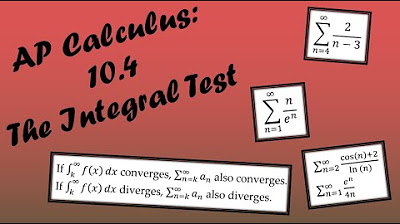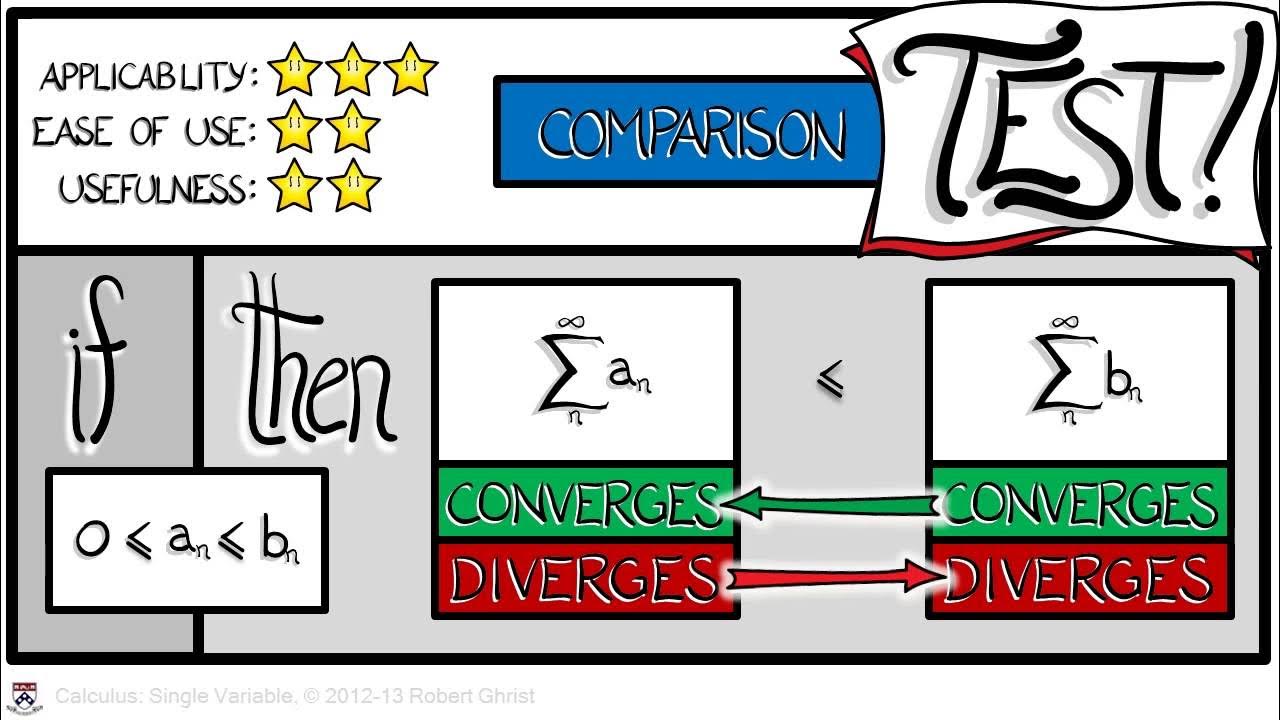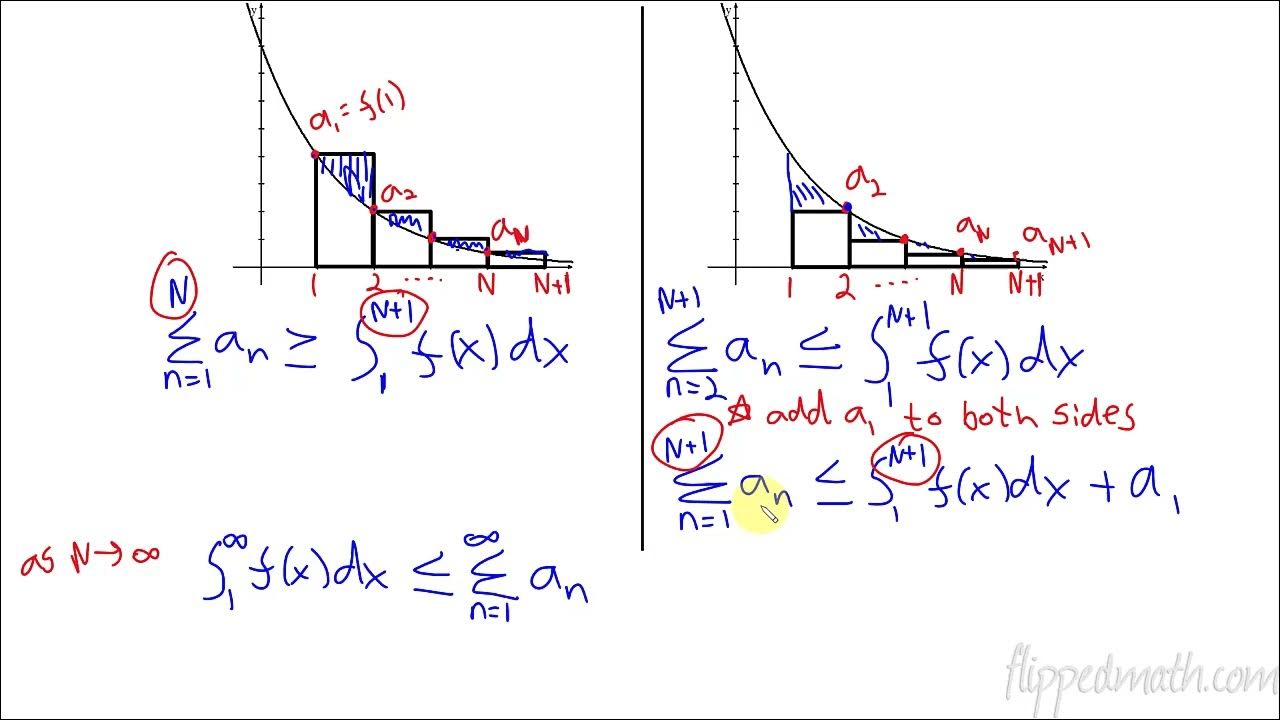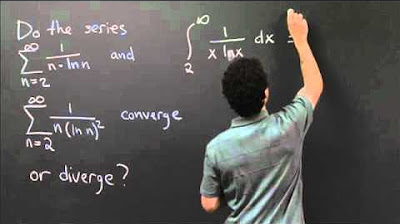Calculus 2 Lecture 9.3: Using the Integral Test for Convergence/Divergence of Series, P-Series
TLDRThe transcript discusses the Integral Test, a method for determining the convergence or divergence of a series by comparing it to an integral. The key idea is that if a series can be modeled by a positive, continuous, and decreasing function, then the integral can act as a bound to determine if the series converges or diverges. The test is applied to various examples, including the P-series, demonstrating its effectiveness in analyzing different types of series. The explanation emphasizes the importance of checking for convergence with the Divergence Test first and then using the Integral Test for a more detailed analysis.
Takeaways
- 📊 The integral test is a method to determine the convergence or divergence of a series by comparing it to an integral.
- 🌟 A series can be represented by a function, and if this function is continuous, positive, and decreasing, the integral test can be applied.
- 🔍 The integral test does not provide the sum of the series but confirms whether the series converges or diverges.
- 💡 The integral acts as an upper bound for the series, helping to determine if the series is finite or tends towards infinity.
- 📈 The concept of integrals adding up areas can be likened to a series adding up terms, which is the basis for the integral test.
- 🎯 The integral test is applicable when the function representing the sequence is positive, continuous, and decreasing on the interval from 1 to infinity.
- 🌐 The convergence or divergence of a series is unaffected by the addition or subtraction of a finite number of terms.
- 🛠️ The integral test can be used as a tool to 'cheat' by starting the integral at a point where the function is positive, continuous, and decreasing, even if the series starts at a different point.
- 📚 Examples in the script demonstrate how to apply the integral test to specific series and functions, highlighting the process of determining convergence or divergence.
- 🔧 The integral test is a powerful tool in calculus for series analysis, but it should be used in conjunction with other tests, such as the divergence test, for a comprehensive assessment.
Q & A
What is the main idea behind using integrals to test for the convergence or divergence of a series?
-The main idea is that integrals can be used to assess whether a series converges to a finite number or diverges to infinity. This is based on the similarity between the process of integrating (adding up areas of rectangles) and the process of summing a series (adding up terms). By comparing the integral of a function that models the sequence of the series, we can determine if the series converges or diverges.
What are the conditions that a function must meet to use the integral test?
-For the integral test to be applicable, the function representing the sequence of the series must be continuous, positive, and decreasing on the interval from a starting point to infinity.
How does the integral act as a bound for the series when using the integral test?
-The integral acts as an upper bound for the series when it converges to a finite number. If the integral diverges, it acts as a lower bound for divergence, indicating that the series also diverges. This is because the integral accumulates areas under the curve, which can be thought of as an approximation of the sum of the series terms.
What is the significance of the Divergence test in the context of the integral test?
-The Divergence test is a preliminary check that can quickly determine if a series diverges. If the limit of the term as n approaches infinity is not zero, the series is guaranteed to diverge. This can save time as it eliminates the need for the integral test in such cases.
Can the integral test determine the exact sum of a convergent series?
-No, the integral test can only determine whether a series converges or diverges. It does not provide the exact sum of the series. It confirms the convergence or divergence nature but not the specific value to which the series converges.
How does the addition or subtraction of a finite number of terms affect the convergence or divergence of a series?
-The convergence or divergence of a series is not affected by the addition or subtraction of a finite number of terms. This allows for some flexibility in how the series is presented or manipulated for testing without changing the fundamental convergence properties.
What is the role of derivatives in showing that a function is decreasing on a given interval?
-Derivatives are used to determine the rate of change of a function. A function is decreasing on a given interval if its derivative is negative for all values within that interval. By showing that the derivative of the function representing the sequence is negative, we can confirm that the function, and hence the sequence, is decreasing.
How does the integral test relate to the comparison test in analyzing series?
-The integral test is a specific method for determining the convergence or divergence of a series, while the comparison test compares an unknown series to a known series (such as a geometric or P series) to determine its convergence based on the behavior of the known series. Both tests rely on understanding the behavior of sequences and their integrals or sums, but the comparison test leverages known results to assess new series.
What is the significance of the integral of 1/x^2 from 1 to infinity in the context of the integral test?
-The integral of 1/x^2 from 1 to infinity is a standard example used to illustrate the integral test. It converges, as the function 1/x^2 is positive, continuous, and decreasing on the interval from 1 to infinity. The convergence of this integral indicates that a series modeled by a similar function would also converge.
How does the concept of a P-series simplify the analysis of certain series?
-A P-series is a specific type of series where the terms are of the form 1/n^p. The integral test can be directly applied to P-series, as the function 1/x^p is positive, continuous, and decreasing for x > 1. If p > 1, the integral from 1 to infinity of 1/x^p converges, indicating that the P-series also converges. If p ≤ 1, the series is compared to the harmonic series or other known divergent series to determine divergence.
Outlines
📚 Introduction to the Integral Test
The paragraph introduces the concept of using integrals to test for the convergence or divergence of a series. It explains the idea by drawing a parallel between the way integrals add up areas under a curve (like little rectangles) and how a series adds up terms. The integral is used as an upper bound to determine if the series converges to a finite number or diverges to infinity. The conditions for using the integral test are also outlined: the function representing the series must be continuous, positive, and decreasing.
🔍 Understanding the Integral Test
This paragraph delves deeper into the integral test, clarifying that while it can determine whether a series converges or diverges, it does not provide the sum of the series. It also discusses the fact that convergence or divergence is unaffected by the addition or subtraction of a finite number of terms, allowing for some flexibility in how the series is represented for testing purposes.
📈 Applying the Integral Test with Examples
The speaker provides examples to illustrate the application of the integral test. They emphasize the importance of checking for convergence or divergence using the divergence test first, and then applying the integral test if necessary. The examples walk through the process of determining if a series converges or diverges by comparing the integral to the series and highlighting how the integral can act as both an upper and lower bound.
🌟 Advanced Application of the Integral Test
The paragraph discusses the application of the integral test to more complex series, such as those involving functions of the form n over n. It explains how to handle these by checking for positivity, continuity, and decreasing nature of the function, and then applying the integral test to determine the convergence or divergence of the series. The speaker also touches on the concept of subtracting a finite number of terms from a series without changing the result of the convergence or divergence.
📝 The P-Series and its Relationship with Convergence
The speaker introduces the P-series, a specific type of series where the terms are of the form 1/n^p. The paragraph explains the conditions under which a P-series converges or diverges, stating that if p is less than or equal to 1, the series diverges, and if p is greater than 1, the series converges. This is a direct application of the integral test, as the P-series can be modeled by a function that is positive, continuous, and decreasing, allowing for easy determination of the series' convergence or divergence.
🎓 Final Thoughts on the Integral Test
The paragraph wraps up the discussion on the integral test by reiterating its usefulness and providing a final example to solidify the concept. The speaker emphasizes the importance of recognizing when a series is a P-series to simplify the convergence or divergence testing process. They also hint at the upcoming topic of the comparison test, setting the stage for the next part of the discussion.
Mindmap
Keywords
💡Integral Test
💡Convergence
💡Divergence
💡Series
💡Function
💡Positive
💡Continuous
💡Decreasing
💡Upper Bound
💡Improper Integral
Highlights
Integral test is introduced as a method to determine the convergence or divergence of a series.
The integral test relies on the comparison of a series to an integral, where the series is represented by a continuous, positive, and decreasing function.
The integral acts as an upper bound for the series, providing insight into its convergence or divergence.
The integral test does not necessarily give the sum of the series, but it confirms whether the series converges or diverges.
Convergence or divergence is unaffected by the addition or subtraction of a finite number of terms in the series.
The concept of positive, continuous, and decreasing functions is crucial for the integral test to be applicable.
The integral test can be seen as a powerful tool for analyzing series, especially when other tests are not applicable or straightforward.
The integral test is applied by comparing the series to an improper integral from 1 to infinity.
The integral test is based on the idea that integrals add up areas, analogous to how a series adds up terms.
The integral test is particularly useful for series that do not meet the criteria for other convergence tests, such as the geometric series or the p-series.
The integral test can be used as a last resort when other series convergence tests fail or are inconclusive.
The concept of the integral test is to model the series after an integral and use the properties of the integral to determine the series' behavior.
The integral test is a general method that can be applied to a wide range of series, given the right conditions.
The integral test is a fundamental concept in calculus that bridges the gap between integrals and series.
The integral test provides a way to determine convergence or divergence without having to find the exact sum of the series, which can be computationally intensive.
Transcripts
Browse More Related Video

AP Calculus BC Lesson 10.4

Calculus Chapter 5 Lecture 51 Convergence Tests 1

Lesson 18 - Integral Test (Calculus 2 Tutor)

Calculus 2 - Geometric Series, P-Series, Ratio Test, Root Test, Alternating Series, Integral Test

Calculus BC – 10.4 Integral Test for Convergence

Integral Test | MIT 18.01SC Single Variable Calculus, Fall 2010
5.0 / 5 (0 votes)
Thanks for rating: